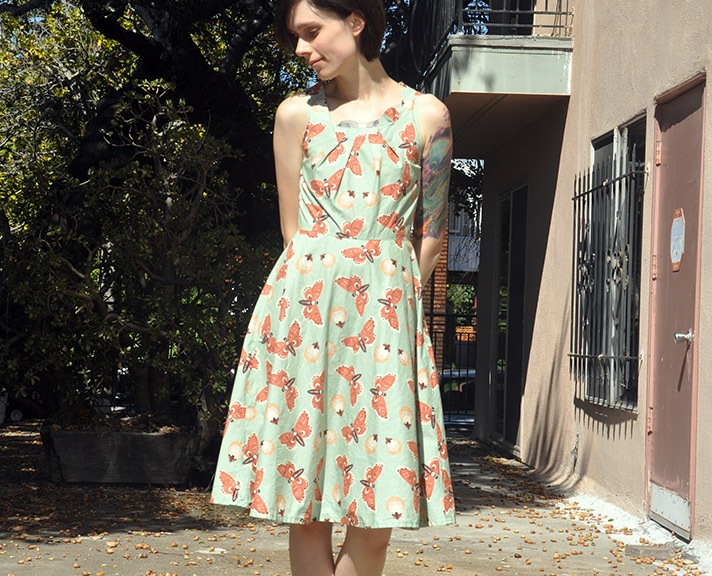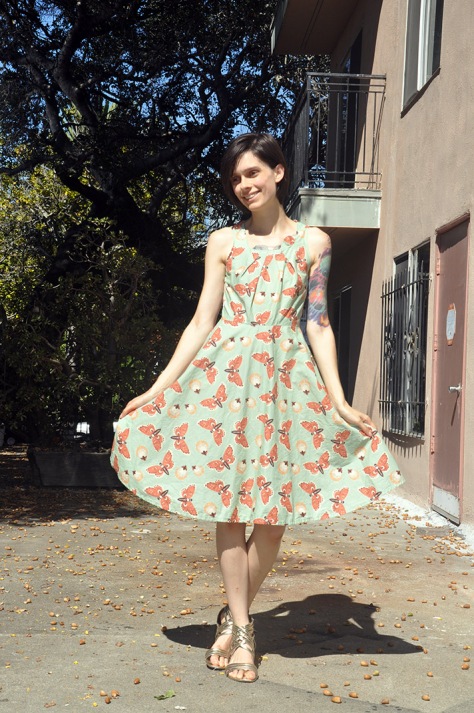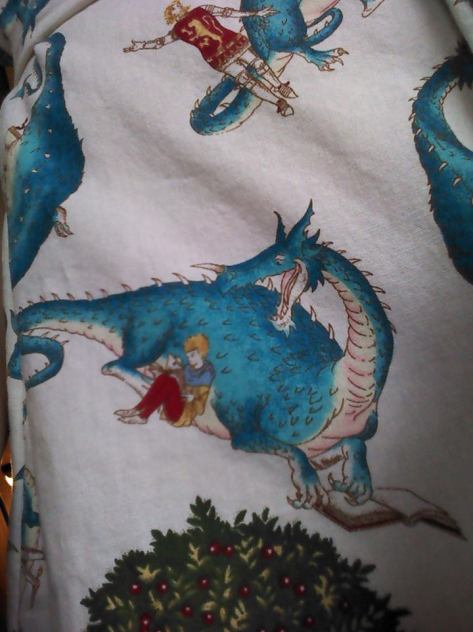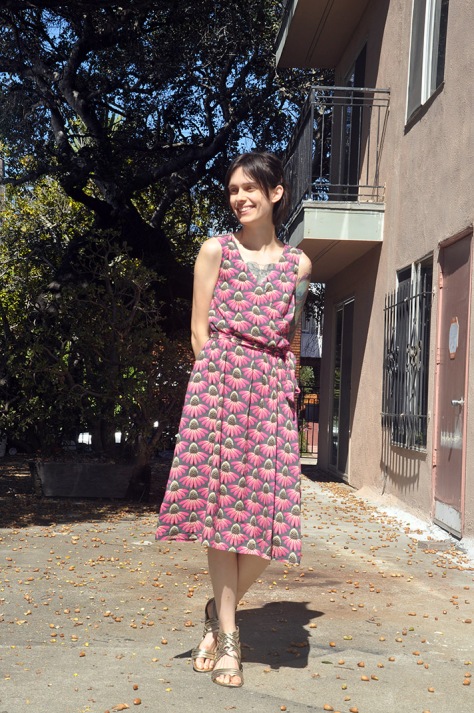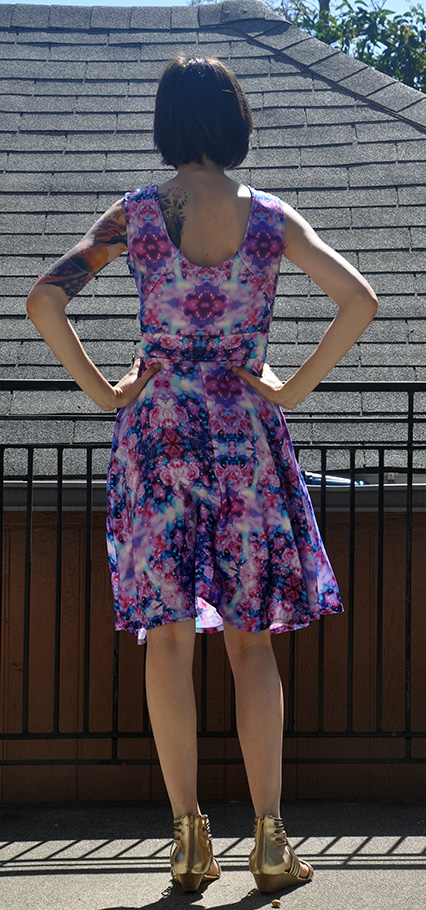Guys, let’s talk for a minute about the really interesting Vogue patterns. You know the ones I’m taking about: the ones with tons of seam lines, or with really unique, structural silhouettes. Usually they’re by designers or masters of the craft, like Ralph Rucci or Claire Schaeffer (two of my favorites, by the way).
Despite how cool these patterns are, and despite the fact that they’re often listed as “owned” or “wishlisted” by a lot of folks on places like Pattern Review (PR), no one ever really talks about making them up. There usually aren’t reviews for them on PR. There usually aren’t a whole lot of blog posts, if any. The only time you see them made up is for sewing conferences, and they’re on a mannequin, and usually photographed with someone’s phone. So you look at the pictures on the Vogue website, and you look at the pictures and drawings on the package, and you say to yourself, “Yeah, that’s great, but what’s it like to actually make this thing?”
Making up these challenging patterns is a mixed bag. Each designer working for Vogue approaches silhouettes, ease, and internal structure differently—and oftentimes, the way they approach these aspects of garment construction are stylized, personalized, and a total train wreck to really fit.
However, obtaining a great fit is central to having a final product that looks just as bam!-pow! As the garment photographed on the pattern package—and sometimes even better (I swear, Rebecca Taylor and Ralph Rucci NEED to send model measurements to Vogue along with their sample garments, because the Vogue models consistently don’t fit in the garments they’re wearing, and that doesn’t help sell patterns at all!).
So how do you do it?
I’d love to say “Make a muslin!” and have that be it, because that’s the big buzz on the blogosphere right now, what with the Ralph Rucci coat sewalong and people getting more and more interested in challenging sewing designs. But I think a lot of people approach muslin-making the wrong way, which makes it a step that is much less effective than it could be.
I had to make this jacket four times to get the garment you see pictured here.
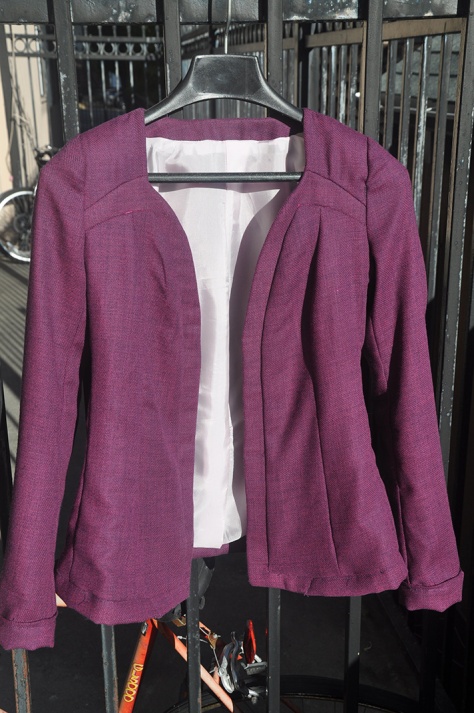

An introduction is in order: audience, meet Vogue 8519. V8519, meet the coolest cats in the blogosphere.
The first time was a muslin. I thought I had it down after that: I did some pinning here, some marking there, and found, to my delight, that the fit seemed really good if I just took out the side panels entirely, and made almost no other adjustments other than the standard (taking in the shoulder width, because apparently Vogue designs for football players, and lengthening the arms by an inch, because I’m lanky).
So after making up this muslin, I said, hey, I got this down, now I can cut out the awesome purple leather I’ve had in my stash for a few months, and make myself a kick-butt purple leather jacket with all these cool seam details.
So I sewed up the bodice, left the sleeves off, and tried it on. Since it was such a disaster I couldn’t even bring up my arms enough to take a picture with my camera, I took a picture of it on a hanger instead:

I ran into problems right away. The shoulders were still far too wide, and what was worse, the front wouldn’t fully close. On top of that, when I attached the sleeves, I found that they were way too wide, and I had almost no arm mobility: my shoulders were totally locked in by the overly-snug fit of the jacket.
Protip: if you find your shoulders are constrained, you can usually fix the problem by ensuring that the seam between the bodice and the sleeve cap rests directly over the shoulder bone (that bony bump sitting toward the end of your shoulder). So I marked where my shoulder bone was and cut the leather.
At the marking, not 5/8” beyond it.
This ruined the leather jacket, and no matter how hard I tried over the next three weeks, I could not salvage the project. Eventually, I gave up and tossed it, though it broke my heart, because that purple leather. But I had no choice—the pattern is made of so many little small pieces that I couldn’t even salvage the leather for a clutch or wallet.
But V8519 continued to nag at me. I was convinced I could get it to work, and what’s more, the spectacular failure had felt like a challenge. Like the pattern was fully expecting me to give up at that point, like it had defeated me. Claimed victory.
Well I wasn’t going to stand for that. It may have won the battle, but I was going to win the war!
I was at work when I found a bolt of burgundy wool suiting and everything started to fall into place. I had bemberg rayon at home, and I knew I had enough to make the lining for the jacket if I was clever in fitting the pieces together. I had shoulder pads and lightweight hair canvas ready for a jacket project.
THIS jacket project.
I gloated as I swept up a few yards and took it home, pretreated it, and then set to work on a third rendition of the jacket—out of cheap cotton, NOT out of the wool. I was hell-bent on getting the fit to be as close to perfect as I was humanly capable of. So I stood in front of the mirror, tweaked the fit. Tested my arm mobility. Pinned the front closed at the button marking and tried again.
Then I marked down everything I had done in a notebook, took all the adjustments out, and tried a different set of adjustments.
I did this what must have been half a dozen times, then eventually settled on the adjustments I thought would work best for me.
Then I set the muslin aside for a week, and worked on something else.
After my mind had cleared of the project, I pulled the muslin out and tried out the fit again. Took out the adjustments. Tried some of the other options. Tested some more, always watching how it looked, whether or not it hung right. I tested my mobility by windmilling my arms, bending down to pick up a pencil, reaching up to pull spices from the top shelf of the kitchen cabinet. I tried hugging my S.O. a bunch of times (he didn’t seem to mind). Punched the air as if in triumph (practice, you understand).
And then, I finally got a fit I was happy with. If you’re curious, here are some recommendations based on my work:
-the bust is actually very shaped: because of the center-front curved piece, the bust is actually able to be cupped over each breast, and this is built (somewhat) into the pattern. This pattern–as with all Vogue patterns–is meant for women with B cups, so you’ll have to be careful about how you do your FBA or SBA. Also remember that when you add/subtract space in the bust, you will have to correspondingly lengthen/shorten the top arc of the center-front curved piece, and you may also have to change the shape of the front yoke. If you’re curious, these are all adjustments that I had to make, since I always have to do an SBA.
-the pattern is designed to be a very loose fit and VERY structured—I think there are only two pieces on the bodice that aren’t supposed to be interfaced with hair canvas. I thought that the style lines suggested something more feminine, so I took everything in quite a bit, and only used hair canvas on the facings, the center-front curved piece, and the bottom hem.
-If you plan to get a tighter fit, here’s the best way to do it: look at the bust/waist/hip final measurements for each size as printed on the tissue paper. A snug-fitting jacket has about 2-3 inches of ease throughout, with a bit more ease around the hips (to enable you to sit comfortably and without the jacket doing unfashionable wrinkling, puckering, or buckling). Choose the WIDTHS of the size that gives you that 2-3 inches of ease all around, but make sure you keep the LENGTH of your true Vogue size, as based on the chart on the back of the envelope. In my case, I am usually a size 10/12, but in the bust and waist I took in the pieces to a size 6/8, left the hips a size 10 where I normally expand out to a size 12, and kept the length a size 10. (This approach also keeps things in much better proportion in the top of the jacket where all that curved-frontispiece nonsense is happening, so you have to do fewer eyeballed modifications for the FBA/SBA! 🙂 )
-Claire Schaeffer must have sloped shoulders, because her designs always call for 1” shoulder pads. I have very straight shoulders that I think are beautiful, and wearing anything substantial over them makes me look WAAAAY too ’80’s, and like I’m trying too hard to be corporate or something… So I chose raglan 1/2” shoulder pads instead, so that the shaping was more feminine and natural, but still gave the garment the structural support it needed.
-the only other stylistic change I made was to omit the front button. Honestly, it just looks a little awkward to me, and I feel like it breaks up the flow of the design as created by the seam lines and piece shapes. Not to mention I had no intention of trying to get a button hole through something that had been interfaced with hair canvas. 😛
~~~
I was absolutely terrified to start cutting the wool, once the muslin was finally finished and the changes had been transferred to the pattern pieces. Occasionally, I had to stop working on the jacket for a week or more, and sew something easy and gratifying (like the By Hand London blazer I posted a few days ago!), because the anxiety over this project was killing me.
But! I’m happy to say that after over a month of fiddling with this pattern, I got something that fit well, and the final result is a bam!-pow! rendition of V8519 that I’m very proud of, and will be wearing a hell of a lot.


It is so rewarding to see something like this grow beneath my hands, and to be able to wear it is…inspiring (not to mention I feel like a million bucks wearing such a unique and TAILORED jacket!). I can confidently take the next step and try things that are even more challenging. I’ve taken my sewing abilities and knowledge to the next level. The project was daunting, and hard…but it was so worth it.
Friends and followers, I am pleased to present you with the remainder of the photo shoot of V8519, in all it’s glory. Enjoy—you’ve earned it if you read through all my notes! Haha!


















